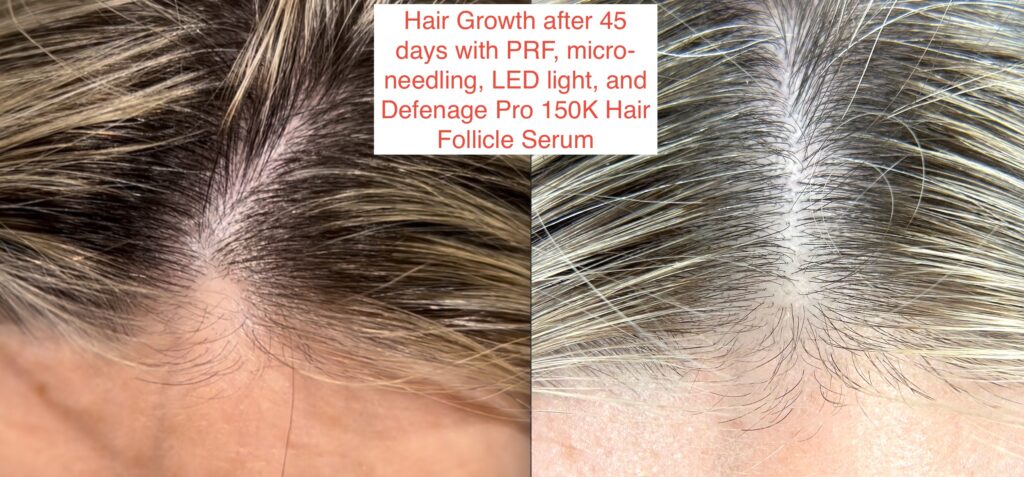Female Hair Loss
Hair loss in females can be very distressing and we find many people don’t really know where to turn to get help. However, there are several possible treatment options available and these will vary depending on the underlying cause.
It should be noted that many of the treatments we will mention are considered off label. However, the FDA approved treatments for female hair loss are very limited so this is clearly an underserved condition!
What are some causes of female hair loss?
It’s very important to consider secondary causes of hair loss in order to appropriately direct treatment.
Hormonal Changes:
Hormonal fluctuations, such as those experienced during pregnancy, childbirth, menopause, or conditions like polycystic ovary syndrome (PCOS), can contribute to hair loss. Androgens, such as testosterone, are especially known to affect hair follicles and lead to thinning hair.
Genetics:
Female-pattern hair loss is a hereditary condition that can cause gradual thinning of hair over time. It tends to run in families and is more common as women age.
Medical Conditions:
Certain medical conditions, such as thyroid disorders (hypothyroidism or hyperthyroidism), autoimmune diseases (like alopecia areata), scalp infections, Covid-19, and chronic illnesses, can lead to hair loss in women.
Stress:
Physical or emotional stress can trigger a type of temporary hair loss called telogen effluvium, where a large number of hairs prematurely enter the resting phase of the hair growth cycle and then shed simultaneously several months later.
Nutritional Deficiencies:
Inadequate intake of essential nutrients such as iron, zinc, vitamin D, and protein, can affect hair growth and contribute to hair loss.
Medications and Treatments:
Some medications, including certain antidepressants, blood thinners, beta-blockers, and chemotherapy drugs, can cause hair loss as a side effect. Additionally, harsh hair treatments like chemical straightening, bleaching, or frequent use of heated styling tools can damage hair and lead to breakage.
Age:
As women age, the rate of hair growth may slow down, and hair follicles may become less productive, leading to overall thinning of the hair.

What are some possible treatment options?
Topical Medications:
Minoxidil (Rogaine) in an over-the-counter medication that is applied directly to the scalp and can help to stimulate hair growth. It is available in various strengths and formulations.
Corticosteroids:
Topical corticosteroids can be prescribed to reduce inflammation and suppress the immune response in conditions like alopecia areata.
Topical Hair Serum:
Defenage Pro 150K Hair Follicle Serum is an example of a medical grade product for hair loss. This is available from select providers and helps to optimize the scalp skin health to create an optimal environment for hair regrowth.
Oral Medications:
Medications such as finasteride, spironolactone, and metformin may be beneficial in women with hair loss related to certain conditions. However, be prepared to discuss potential side effects and contraindications, especially in women of childbearing age.
Hormone Therapy:
Hormonal imbalances, such as those related to polycystic ovary syndrome (PCOS) or menopause, may contribute to hair loss. Hormone therapy may be prescribed to address these imbalances.
Nutritional Supplements:
Supplements containing vitamins, minerals, and amino acids essential for hair growth, such as biotin, iron, zinc, and vitamin D, may be recommended to support hair health.
Platelet-Rich Plasma (PRP) or Platelet-Rich Fibrin (PRF):
PRP and PRF treatment involves injecting platelet-rich plasma derived from the patient’s own blood into the scalp to stimulate hair follicles and promote hair growth. This has been shown to be somewhat more effective in women than men and may require multiple treatments to show effect.
Micro-needling:
This therapy involves using a device that makes tiny micro-punctures in the skin. This controlled trauma can stimulate skin health and a variety of solutions including topical serums, exosomes, PRP, or PRF can all be applied and “micro-needled” into the scalp for improved effect.
LED Light Therapy:
This completely noninvasive therapy involves using an LED light that emits very specific wavelengths to stimulate cells and hair follicles in the scalp and promote hair growth.
Combination Therapy:
While individual responses to treatment vary, many providers agree that a multi-faceted approach seems to work better and more quickly for most people than trying individual therapies.
At Believe Image, we take hair loss very seriously. If you are experiencing this issue, consult with us or another qualified health professional to find out an appropriate treatment plan tailored to your specific needs.
